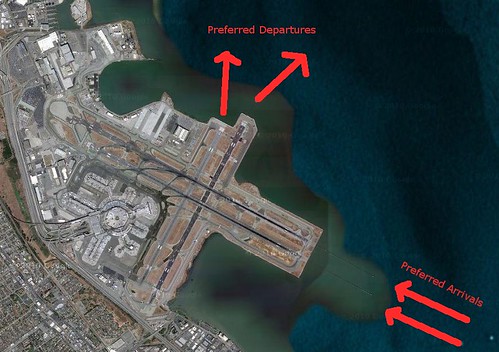Pop quiz. Which major airport had the worst on time performance in August? JFK? Nah. Newark? Nope. Chicago? Bzzt. Atlanta? Nyet. Give up? It’s San Francisco. Really.
You would think that the airports that get pounded by thunderstorms all summer would be the ones that rank at the bottom, so it’s even more surprising that San Francisco sits below everyone else by a fair margin. There wasn’t a single drop of rain the entire month at the airport. San Francisco saw only 70.2 percent of flights arrive within 15 minutes of schedule in August. The next worst was Miami at 75.9 percent and then LaGuardia at 76.4 percent. So what gives?
Those of you who live in the Bay Area or fly there frequently are probably shaking your heads right now because you know the pain all too well. The problem? It’s too foggy at the airport by the Bay and the runways are too close together to operate at full capacity in the fog. In a city that loves the environment more than just about anything, this isn’t likely to get fixed any time soon.
But before we dig into the reasons, I’ll put up a virtual layout of the Bay Area for those who don’t know it. (Before you jump on me with hate-spewing comments, realize that I absolutely love it up there, so this map was drawn with love. Well, except for that part about Berkeley. As a Stanford grad, I have no love for you weenies in the East Bay.)
As you can see, SFO sticks out into the Bay from the peninsula, just south of the city of San Francisco itself. In case you were wondering, much of the peninsula there is made up of mountains and the area between the mountains and the Bay is filled with people. The airport has nowhere to go. Now let’s look at the airport in greater detail.
Here you can see the airport up close. It has two sets of parallel runways that are perpendicular to each other. When the winds allow, the airplanes come in from the east and land over the Bay. Departures go to the north. (Yes, some long haul departures use the same runways as arrivals because the runways are so much longer.) But it’s not shifting winds that cause the airport to back up. The problem actually usually happens when airplanes are using this preferred configuration.
On a beautiful sunny day, the controllers can line up airplanes to land simultaneously. The runways are only 750 feet apart (centerline to centerline) but when the airplanes can see each other, that’s ok. When airplanes can’t see each other and they need to do instrument landings, the required distance between runways goes up a lot. You need 2,500 feet to do staggered approaches and 4,300 feet to do approaches exactly parallel to each other. SFO isn’t even close.
There are two ways to solve this problem. One is the technological way – get more accurate systems that allow for airplanes to be much closer to each other even when they can’t see each other. That has happened to some extent as airlines have worked with the airport and the feds to come up with ways to increase the throughput when visibility drops. The other way is to physically move the runways. The only real option there is to push one runway further out to the north into the Bay. I think we all know that in a place like San Francisco, that’s not going to happen. Environmentalists will win that battle every time.
So instead, air travelers just end up suffering any time the visibility goes down. What’s most frustrating about that is it’s very often a beautiful sunny day until the last few miles of the approach when that fog messes things up. In August, that happens a fair bit, and it’s why SFO had the worst on time performance despite not having a drop of rain.
The strangest thing about all this is when flying to San Francisco, you should throw all other advice out the window. What do people usually tell you? Fly in the morning to avoid delays, right? Not to San Francisco. As you might imagine, fog is worse in the morning and will often clear out by afternoon. So the afternoon arrivals are in better shape than the morning ones. Here’s the chart.
Definitely not what you’d expect to see at most airports, right? So next time you’re flying into SFO, keep that in mind. Afternoon flights might work out better, or if you really don’t want to take chances, there’s always Oakland . . .



